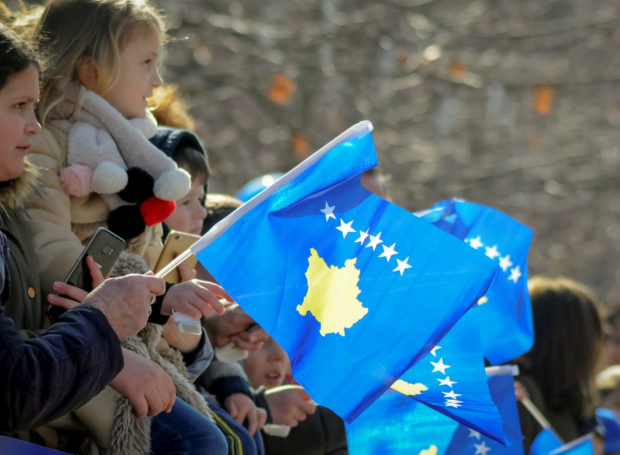
People attend celebrations of the 11th anniversary of Kosovo independence in Pristina, Kosovo, February 17, 2019. REUTERS FILE PHOTO
Fifteen years after Kosovo declared independence, 50,000 minority Serbs in the north bordering Serbia refuse to recognize state institutions, get pay and benefits from Serbia’s budget and pay no taxes either to Pristina or Belgrade.
Tensions rose further recently as Serbs left all state bodies in the region including the judiciary and law enforcement and as state authorities stepped up a crackdown on cross-border smuggling, began building a border police base and acted to have Serbs switch their car registrations from Serbia to Kosovo.
Here are some facts about an enduring stand-off that fuels Western Balkans instability and must be settled to help meet conditions for Kosovo’s aspiration to join the European Union:
What is the root of the tensions?
Independence for ethnic Albanian-majority Kosovo came on Feb. 17, 2008, almost a decade after a guerrilla uprising against repressive Serbian rule, and is recognized by more than 100 countries.
Serbia, however, still formally deems Kosovo to be part of its territory and denies suggestions it is whipping up strife within its neighbors borders. Belgrade accuses Pristina of trampling on the rights of minority Serbs.
Ethnic Serbs account for 5% of Kosovo’s 1.8 million people, and ethnic Albanians about 90%. Serbs in north Kosovo vent their rejectionism by refusing to pay the state utility for energy they use and often attacking police who try to make arrests.
What’s driving worsening tensions?
North Kosovo Serbs on Dec. 10 erected multiple roadblocks and exchanged fire with police after a former Serb policeman was arrested for allegedly assaulting serving police officers during a previous protest.
But tensions had been ticking upward for months in a dispute over car license plates. Kosovo has for years wanted Serbs in the north to switch their Serbian license plates, dating to the pre-independence era, to ones issued by Pristina, as part of its policy to assert authority over all of Kosovo territory.
On July 31, Pristina announced a two-month window for the plates to be switched over, triggering unrest, but after EU crisis mediation later agreed to push the implementation date back to the end of 2023.
Ethnic Serb mayors in northern municipalities, along with local judges and 600 police officers, resigned in November
in protest at the looming switch, deepening dysfunction and lawlessness in the region.
What do the Serbs ultimately want?
Serbs in Kosovo seek to create an association of majority-Serb municipalities operating with considerable autonomy. Pristina rejects this as a recipe for a mini-state within Kosovo, effectively partitioning the country along ethnic lines. Serbia and Kosovo have made little progress on this and other issues since committing in 2013 to a EU-sponsored dialogue aimed at normalizing ties, for both a requirement for EU membership.
What is the role of Nato and the EU?
NATO retains 3,700 peacekeeping troops in Kosovo, the remainder of an original 50,000-strong force deployed in 1999. The alliance says it would intervene in line with its mandate if Kosovo were at risk of renewed conflict. The EU’s EULEX mission, begun in 2008 to train domestic police and crack down on graft and gangsterism, retains 200 special police officers in Kosovo.
What is the latest EU peace plan?
U.S. and EU envoys are pressing Serbia and Kosovo to approve a plan presented in mid-2022 under which Belgrade would stop lobbying against a Kosovo seat in international organizations including the United Nations. Kosovo would commit to form an association of Serb-majority municipalities. And both sides would open representative offices in each other’s capital to help resolve outstanding disputes.
What do Serbia, Kosovo think of it?
Serbia’s president appears ready to approve the plan, warning recalcitrant nationalists in parliament Belgrade will otherwise face damaging isolation in Europe. Kosovo’s prime minister said yes with caveats, calling it a “solid platform” for further talks on steps such as “international guarantees” – mooting possible terms for local Serb self-governance. But with nationalist hardliners powerful on both sides, not least among north Kosovo Serbs, no breakthrough is on the horizon.
What’s at state for the local Serb population?
The area of north Kosovo where Serbs form a majority is in important ways a virtual extension of Serbia. Local administration and public servants, teachers, doctors and big infrastructure projects are paid for by Belgrade. Local Serbs fear that once fully integrated within Kosovo they could lose benefits such as Serbia’s free public healthcare and be forced onto Kosovo’s private healthcare system. They also fear pensions would be smaller, given that average monthly pension in Kosovo is worth 100 euros ($106.70) compared with 270 euros in Serbia.
($1 = 0.9372 euros)
RELATED STORIES
Serbia troops on ‘highest level’ of alert over latest Kosovo tensions
Why ethnic tensions are flaring again in northern Kosovo